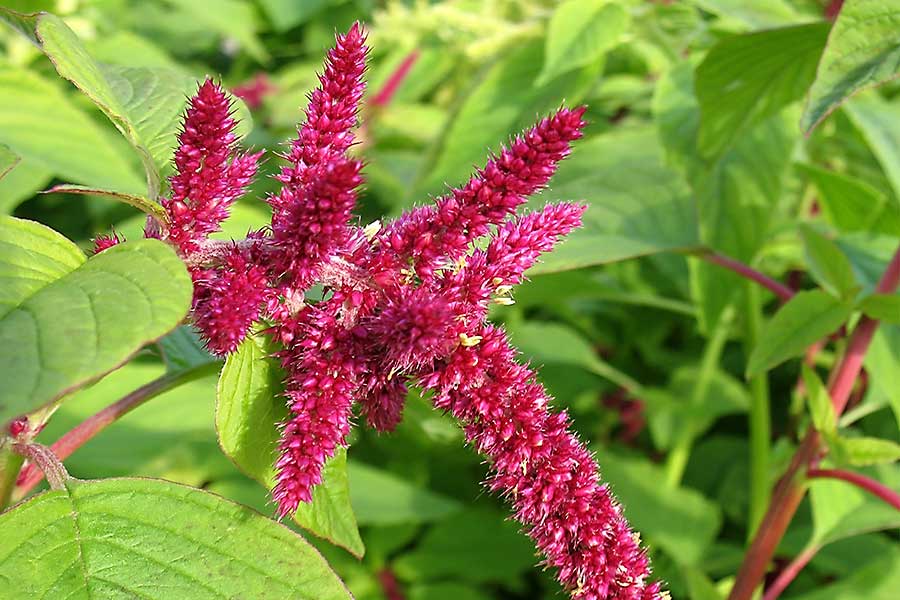
Introduction
Amaranth (Amaranthus spp.) is a versatile crop grown for its leaves (vegetable) and seeds (pseudo-cereal). Known for its nutritional value, it thrives in varied climatic conditions, making it a staple in many regions worldwide. Amaranth is renowned for its resilience, fast growth, and high tolerance to drought and poor soil conditions.
Botanical Information
- Family: Amaranthaceae
- Common Names: Amaranth, pigweed, chaulai (India), callaloo (Caribbean)
- Species:
- Amaranthus hypochondriacus: Grain amaranth.
- Amaranthus cruentus: Dual-purpose (leafy and grain).
- Amaranthus tricolor: Popular for leafy vegetable use.
Origin and History
- Origin: Believed to have originated in Central and South America, especially in Mexico and Peru.
- Historical Significance: Cultivated by ancient civilizations like the Aztecs and Mayans for food and ceremonial purposes.
Global and Indian Distribution
- Worldwide:
- Countries: Mexico, USA, China, Peru, and African nations.
- Usage: Grain and leafy production.
- India:
- Grown widely in Uttar Pradesh, Tamil Nadu, Maharashtra, Gujarat, and Karnataka.
- Used as a leafy vegetable and occasionally for grain.
Nutritional Benefits
- Seeds:
- Rich in protein (12–18%), dietary fiber, and essential amino acids, including lysine.
- Gluten-free and high in calcium, magnesium, and iron.
- Leaves:
- Excellent source of Vitamin A, Vitamin C, and antioxidants.
- Contains iron, calcium, and folate.
Climatic and Soil Requirements
- Climate:
- Warm climates with a temperature range of 22–30°C.
- Can tolerate drought and high temperatures due to its C4 photosynthetic system.
- Rainfall: Moderate rainfall (500–800 mm).
- Soil:
- Prefers well-drained sandy loam with organic matter.
- pH range: 6.0–7.5.
- Tolerates poor and saline soils.
Varieties of Amaranth
- Grain Amaranth: Suvarna, GA-1, GA-2.
- Vegetable Amaranth: Pusa Lal Chaulai, Arka Suguna, CO-1.
- Dual-Purpose Varieties: Annapurna, Arka Arunima.
Sowing
- Seed Rate:
- Grain: 1–1.5 kg/ha.
- Leafy: 2–3 kg/ha.
- Time of Sowing:
- February–March (spring).
- June–July (monsoon).
- Method:
- Direct sowing or transplanting.
Spacing
- Grain: 30–40 cm between rows, 10–15 cm between plants.
- Leafy: 20 cm × 20 cm.
Fertilizer Requirements
- Basal Application:
- 10–12 tonnes/ha of FYM.
- NPK Fertilization:
- 40:20:20 kg/ha (Nitrogen, Phosphorus, Potassium).
- Top dressing: 20 kg/ha nitrogen during vegetative growth.
Irrigation
- Requires 3–4 irrigations.
- Critical stages: Germination, flowering, and grain filling.
Weed Management
- Manual weeding twice: at 15 and 30 days after sowing.
- Mulching helps suppress weed growth.
Pest and Disease Management
- Pests:
- Aphids: Control with neem oil or insecticides.
- Leaf Miners: Use yellow sticky traps.
- Diseases:
- Leaf Spot: Managed with fungicides like mancozeb.
- Downy Mildew: Prevent with proper aeration and systemic fungicides.
Harvesting and Yield
- Leaf Harvesting:
- 25–30 days after sowing for tender greens.
- Grain Harvesting:
- When seed heads turn golden brown, typically 90–120 days after sowing.
- Yield:
- Grain: 800–1200 kg/ha.
- Leaves: 15–20 tonnes/ha.
Uses
- Food: Grain used in cereals, breads, and snacks. Leaves consumed fresh, cooked, or in salads.
- Animal Feed: Nutritious fodder for livestock.
- Industrial Uses: Grain for starch and gluten-free products.
- Medicinal: Anti-inflammatory and cholesterol-lowering properties.
Physiological Disorders
- Bolting: Premature flowering due to high temperatures or water stress.
- Nutrient Deficiency: Stunted growth or yellowing leaves due to nitrogen or iron deficiencies.
Economic and Environmental Significance
- Economic: A low-input crop with high returns. Provides livelihood in arid and semi-arid regions.
- Environmental: Contributes to biodiversity and sustainable farming systems. Drought tolerance makes it suitable for climate-resilient agriculture.

